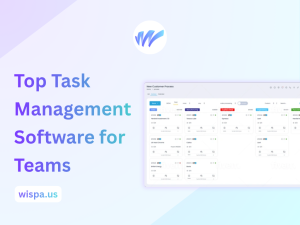
The Best Productivity Tools for Work in 2025
The modern work environment demands speed, precision, and collaboration. Managing multiple projects, deadlines, and communication channels can feel overwhelming. The right set of productivity tools can make all the difference, acting as a digital assistant to streamline tasks, enhance team synergy, and significantly boost overall efficiency. By automating the mundane and organizing the complex, these applications free up valuable time for more strategic, high-impact work.
This guide will explore the best productivity tools for work available in 2025. We will define what these tools are, break them down into essential categories, and highlight their benefits. You’ll learn how to choose the right productivity manager software for your needs and see real-world examples of how these tools transform workflows.
What Are Productivity Tools?
Before exploring the specific recommendations, it’s important to understand the basics. Productivity tools are software applications designed to help individuals and teams manage their work more effectively. Their primary role is to simplify processes, organize information, and facilitate communication, ultimately allowing users to accomplish more in less time. These can range from simple to-do list apps to comprehensive project management platforms. The core idea is to reduce friction and cognitive load, making work smoother and more focused.
Examples of Productivity Tools
The landscape of software productivity tools is vast. Here are a few productivity software examples:
- Project Management: Tools for planning, executing, and monitoring projects.
- Communication: Platforms that enable instant messaging, video calls, and file sharing.
- Time Tracking: Applications that monitor time spent on various tasks to improve efficiency.
- Note-Taking: Digital notebooks for capturing ideas, meeting minutes, and research.
Why Productivity Tools Matter
Using the right tools for productivity offers substantial benefits. For individuals, they help manage personal workload and reduce stress. For teams, they create a cohesive environment where everyone is aligned and informed. For businesses, these business productivity apps lead to improved output, better resource allocation, and a stronger bottom line. They are essential for maintaining a competitive edge.
Top Categories of Productivity Tools
Productivity applications can be grouped into several key categories, each addressing a specific workplace challenge.
1. Project Management Tools
These are the command centers for any team project. They provide a centralized platform to manage tasks, assign responsibilities, set deadlines, and track progress. Tools like Wispa, nTask, and GanttPro are excellent for keeping projects on schedule and ensuring everyone knows what they need to do. When choosing a tool, look for features like task dependencies, milestone tracking, and robust reporting dashboards. They are among the most effective tools for team productivity.

2. Communication Tools
Clear and instant communication is the bedrock of collaboration. While email has its place, dedicated communication platforms like Wispa, Slack, Chanty, and Fleep eliminate the clutter and delays of traditional correspondence. They offer channels for specific topics or projects, direct messaging, and integrations with other apps. These tools ensure that important conversations are organized, searchable, and accessible to the entire team, fostering a more connected and responsive workplace.

3. Time Tracking Tools
Do you know where your time really goes? Time tracking tools like Wispa, Toggl, Harvest, and Hubstaff provide the answer. By logging the time spent on different tasks and projects, individuals and teams can identify inefficiencies, make more accurate project estimates, and improve accountability. The data gathered from these tools is invaluable for optimizing workflows and ensuring that effort is focused on the most critical activities.

4. Note-Making Tools
Great ideas can strike at any moment. Note-making applications for productivity like Evernote, Microsoft OneNote, and Google Keep give you a place to capture, organize, and share them. Whether you’re jotting down meeting notes, creating a research repository, or brainstorming a new concept, these tools ensure your thoughts are saved and easily retrievable. Many also offer features like web clipping, document scanning, and collaboration, making them a powerful productivity tool.
5. Scheduling and Calendar Tools
Effective time management starts with a well-organized schedule. Tools like Calendar and Google Calendar go beyond simple appointment booking. They help you manage your availability, schedule meetings without endless back-and-forth emails, and set reminders for important deadlines. By providing a clear overview of your commitments, these office productivity tools help you protect your focus time and maintain a healthy work-life balance.

6. Email Management Tools
The average professional spends hours each day managing their inbox. Email management tools like Wispa, Clean Email, Right Inbox, and Sanebox are designed to reclaim that time. They use smart filters and automation to declutter your inbox, unsubscribe from junk mail, and bundle non-urgent messages for later review. This allows you to focus on the emails that truly matter and turn your inbox into a streamlined communication hub instead of a source of distraction.

7. Focus and Distraction-Blocking Tools
In an always-on world, deep work requires deliberate effort. Focus tools like Freedom, Forest, and Self-Control help you create a distraction-free environment by temporarily blocking access to certain websites and applications. By setting a timer and committing to a focused work session, you can train your brain to resist interruptions and achieve a state of flow, dramatically increasing the quality and quantity of your output.
Benefits of Using Productivity Tools
Adopting the right set of productivity tools for office work and remote settings yields tangible benefits across the board.
- Improved Efficiency: By automating repetitive tasks and organizing workflows, these tools allow you to work smarter, not harder.
- Better Collaboration: Centralized communication and project platforms ensure teams are aligned, reducing misunderstandings and rework.
- Time Management: Tracking features provide clear insights into how time is spent, enabling better planning and prioritization.
- Reduced Stress: An organized digital workspace means less time searching for information and worrying about missed deadlines, leading to lower stress levels.
Emerging Trends in Productivity Tools
The world of productivity tools is constantly evolving. Three major trends are shaping the future of these applications.
- AI-Powered Tools: Artificial intelligence is being integrated to automate complex tasks, provide predictive insights, and offer smart suggestions. For example, an AI might suggest the best time to schedule a meeting based on everyone’s calendar and focus patterns.
- Integration Capabilities: The best tools for productivity don’t operate in a silo. Modern tools are designed to seamlessly integrate with each other, creating a unified workflow where data flows effortlessly between your project management, communication, and email apps.
- Mobile-First Tools: With work becoming more flexible, the ability to be productive on the go is crucial. Developers are increasingly creating mobile-first applications that offer full functionality on smartphones and tablets, allowing you to manage your work from anywhere.
How to Choose the Best Productivity Tools for Work
With so many options, selecting the right tools can be daunting. Follow this simple three-step process to find the perfect fit.
- Assess Your Needs: Start by identifying your biggest challenges. Are you struggling with missed deadlines, poor communication, or constant distractions? Your specific pain points will determine which category of tools to prioritize.
- Compare Features: Once you know what you need, evaluate different options based on their features, ease of use, and cost. Read reviews and look for a tool that strikes the right balance for your team’s size and budget.
- Test Before You Commit: Almost every reputable productivity manager software offers a free trial. Take advantage of it. Use the tool with your team on a real project to see if it fits your workflow and delivers on its promises.
Case Studies: Productivity Tools in Action
Let’s look at how the best productivity tool choices can have a real-world impact.
1. Wispa for Project Management
A marketing agency was struggling to manage multiple client campaigns simultaneously. Deadlines were being missed, and communication was scattered across emails and spreadsheets. After adopting Wispa, they were able to create a central dashboard for every project. Tasks were clearly assigned, progress was visible to everyone, and automated reminders kept the team on track. As a result, they improved on-time delivery by 40% and significantly increased client satisfaction.(G2 – Review)
2. Slack for Communication
A software development company with employees across different time zones faced challenges with collaboration. Important decisions were delayed waiting for email responses. By implementing Slack, they created dedicated channels for each feature they were building. Developers, designers, and project managers could communicate in real-time, share code snippets, and get instant feedback. This shift from asynchronous email to synchronous chat dramatically accelerated their development cycle.
Conclusion
In today’s fast-paced, high-demand work environment, the right productivity tools are essential—not optional. They help manage complex projects, streamline workflows, enhance collaboration, and minimize distractions, allowing you to focus your time and energy where it matters most. By integrating the right tools, you can boost efficiency, reduce stress, and achieve better results with less effort. The key is finding the mix that best fits your unique needs. Explore different options and start experimenting—begin with an all-in-one platform like Wispa to transform project management and experience how the right technology can truly revolutionize your work.
Frequently Asked Questions
Productivity tools are software and applications designed to help individuals and teams manage their work more efficiently. Their main purpose is to streamline workflows, improve organization, and enhance communication, which allows you to get more done in less time.
Using the best productivity tools for work offers several key advantages that can transform the way you operate daily. They significantly improve efficiency by automating routine tasks and streamlining workflows, allowing you to focus on what truly matters.
To choose the best tool, first assess your team’s specific needs and pain points. Next, compare the features, ease of use, and pricing of different options. Finally, take advantage of free trials to test the tools in a real-world setting before making a final commitment.
Yes. By helping you organize tasks, manage deadlines, and streamline communication, productivity tools reduce the chaos and uncertainty that often lead to stress. A well-organized digital workspace means less time spent searching for information and worrying about what you might have forgotten.
Project management tools like Wispa provide a central platform where teams can plan projects, assign tasks, set deadlines, and track progress. This visibility ensures everyone knows their responsibilities and deadlines, which prevents bottlenecks, reduces rework, and helps keep the entire project on schedule.




